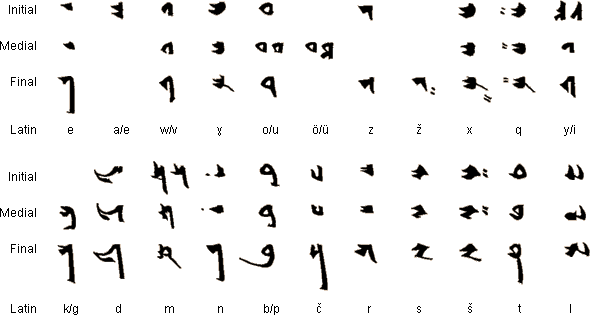Uighur alphabet
| Uighur alphabet | ||
|---|---|---|
| Font | Abdschad / Alphabet | |
| languages | Old Uyghur | |
| Usage time | 8th to 18th centuries | |
| Used in | Central Asia | |
| ancestry |
Protosinaitic script → Phoenician script → Aramaic script → Syriac script → Sogdic script → Uighur alphabet |
|
| Derived | Mongolian script | |
| particularities | vertically from right to left | |
The Uyghur alphabet is derived from the Sogdian alphabet from the Aramaic , with which the ancient Uyghur language was written.
However, the so-called modern Uighur is not written with this alphabet . Since Uyghur was spelled differently in the Soviet Union and China and the writing system changed several times, especially in China, a Persian-Arabic , a Cyrillic and sometimes a Latin alphabet are used for modern Uyghur.
Writing direction
The Uighur script is written from top to bottom, so the lines run vertically. The next vertical line then follows to the left of it, that is, the arrangement is the same as the traditional Chinese.
history
The first written evidence of Old Uyghur comes from the 5th century AD and was written in the Sogdian script , the 90 ° rotated variant of an Aramaic-Syrian cursive script. In addition to it, the Orkhon runes were sometimes used. The Sogdian script finally developed into the Uighur script in the 10th century. With the Islamization of the Uyghurs, the Uyghur alphabet was gradually replaced by the Arabic alphabet , another descendant of the Aramaic alphabet and, historically speaking, only has an indirect reference to the old Uighur alphabet. Thus, the Uighur alphabet, like almost all letter scripts in the world, can ultimately be traced back to the Phoenician script .
The Uighur alphabet was adopted by the Mongols as the Mongolian alphabet from the time of Genghis Khan .
Footnotes
- ↑ An Introduction to Latin-Script Uyghur (PDF; 462 kB)

